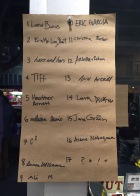Choreography by Hope Mohr
Almost Caught Up
The first weeks in June were busy, but I’m almost caught up now. I saw Hope Mohr Dance three times last year. Mohr is a sharp a choreographer, curator, and director. I am definitely looking forward to her work in the 2016 Bridge Project at Yerba Buena Center for Arts in the Fall.
Mohr is not afraid to think nor is she afraid to show the audience how she thinks. In many ways, Manifesting, is about thinking, about the process of thinking. It is also a dance about speech, of calling out and being called. Mohr states that Manifesting, “inspired by artist manifestos, flows from [her] curiosity about the interplay between desires and rules in the creative process.” So it is also a dance about moving between woulds (desires) and shoulds (rules). Manifest, an adjective, suggests something that is clear or obvious whereas manifest, a verb, suggests the display or show of something. A manifesto, a noun, is a public declaration of change that arises out of a tension between creative impulses and restrictive norms.
What, then, is manifesting? What kind of action? What kind of process?
I liked walking into the theater and seeing the stage look different with conference tables, low lighting, and telephones. It looked more like an office than a stage. I got a giggle from the costumes as it reminded me of an old joke: what is red, white, and black all over? (answer: a newspaper). The written word is referenced not only in the costumes but also in the dance as Mohr incorporates spoken word and singing. It seems then that manifesting as it is articulated in the dance has something to do with the actualization of words. The refrain, “please speak louder” amplified this notion for me. Because I am writing this from many weeks past my watching the details of the choreography are a bit fuzzy and then I wonder if this has to do with the abundance of words in the piece.
I didn’t take too many notes of Stay and when I saw it last year, I didn’t write about the details of the piece. I remember liking its sexiness and sophisticated movement, and this time, I felt a little less of this. Why repeat this dance? Why did it’s repetition matter? I wonder if it has something to do with the need to fill time. Why not just show Manifesting? I ask these questions because I talked with a few people afterwards (at the theater and on the bus), and they seemed a little weary. Did Mohr ask too much from her audience? Maybe and maybe not. Even so, I’m still a fan.




